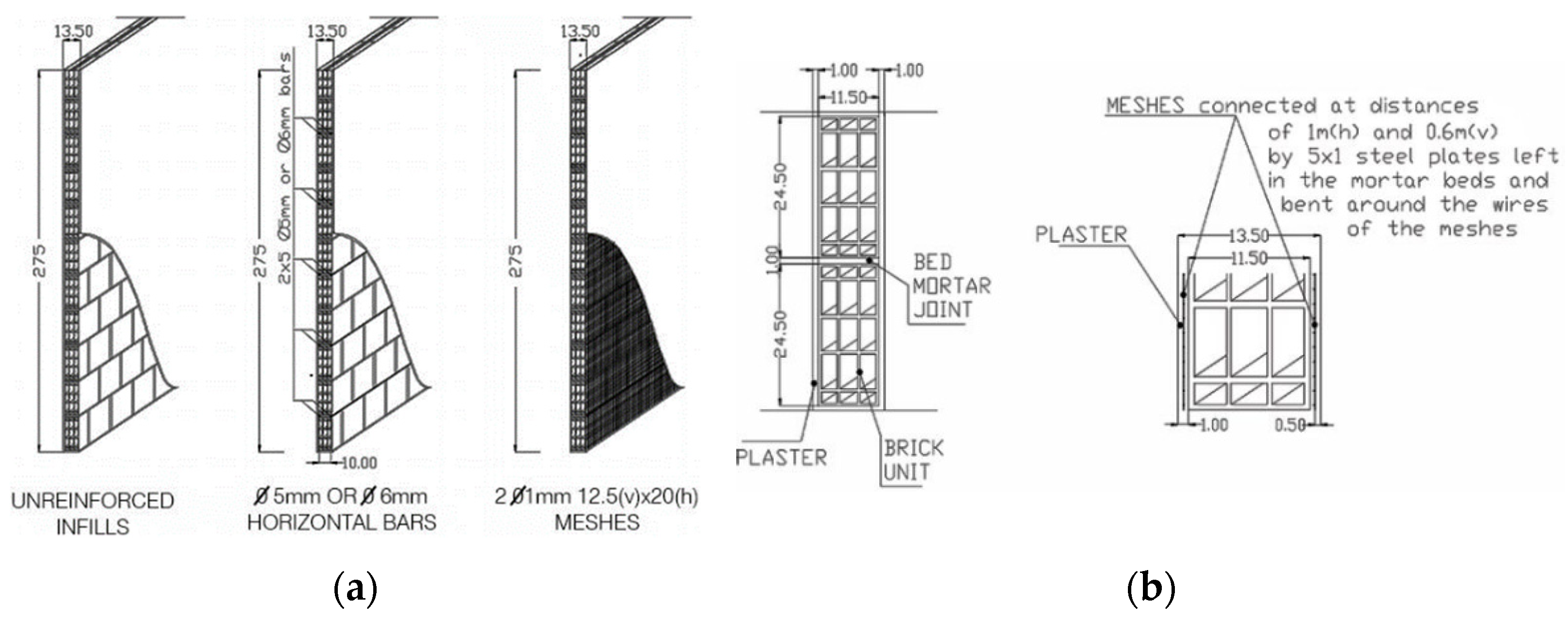Design Proposal for Masonry Infill Walls Subject to Seismic Actions
Abstract
:1. Introduction
2. Out-of-Plane Behaviour of Masonry Infill Walls
2.1. Experimental Research Studies
2.2. Code Proposals
3. Shake Table Tests
3.1. Building Models
3.2. Shake Table Input and Acquisition Setup
4. Comparison of the Experimental Results with Design Standards
4.1. Demand
4.2. Capacity
5. Design Proposal
5.1. Out-Of-Plane Modal Frequency
5.2. Out-of-Plane Capacity Reduction
6. Conclusions
Author Contributions
Funding
Institutional Review Board Statement
Informed Consent Statement
Conflicts of Interest
References
- Mehrabi, A.B.; Shing, P.B.; Schuller, M.P.; Noland, J.L. Performance of Masonry-Infilled R/C Frames under In-Plane Lateral Loads; Report No. CU/SR-94-6; University of Colorado: Boulder, CO, USA, 1994. [Google Scholar]
- El-Dakhakhni, W.; Elgaaly, M.; Hamid, A. Three-Strut Model for Concrete Masonry-Infilled Steel Frames. J. Struct. Eng. 2003, 129, 177–185. [Google Scholar] [CrossRef]
- Tiedemann, H. A statistical evaluation of the importance of non-structural damage to buildings. In Proceedings of the 7th WCEE, Istanbul, Turkey, 8–13 September 1980; pp. 617–624. [Google Scholar]
- McDowell, E.L.; McKee, K.E.; Sevis, E. Arching action theory of masonry walls. J. Struct. Div. 1956, 82, 915-1. [Google Scholar] [CrossRef]
- Hendry, A.W. The lateral strength of unreinforced brickwork. Struct. Eng. 1973, 51, 43–50. [Google Scholar]
- Anderson, C. Arching action in transverse laterally loaded masonry wall panels. Struct. Eng. B 1984, 62, 12–23. [Google Scholar]
- Dawe, J.L.; Seah, C.K. Out-of-plane resistance of concrete masonry infilled panels. Can. J. Civ. Eng. 1989, 16, 854–864. [Google Scholar] [CrossRef]
- Flanagan, R.D.; Bennett, R.M. Arching of masonry infilled frames: Comparison of analytical methods. Pract. Period. Struct. Des. Constr. 1999, 4, 105–110. [Google Scholar] [CrossRef]
- Flanagan, R.D.; Bennett, R.M. Bidirectional behaviour of structural clay tile infilled frames. J. Struct. Eng. 1999, 125, 236–244. [Google Scholar] [CrossRef]
- Angel, R. Behavior of Reinforced Concrete Frames with Masonry Infills; Department of Civil Engineering, Illinois at Urbana-Champaign: Champaign, IL, USA, 1994. [Google Scholar]
- Klingner, R.E.; Rubiano, N.R.; Bashandy, T.R.; Sweeney, S. Evaluation and analytical verification of shaking table data from infilled frames. Part 1: In-plane behaviour. In Proceedings of the 7th North American Masonry Conference, South Bend, IN, USA, 2–5 June 1996. [Google Scholar]
- Cohen, E.; Laing, E. Discussion to “arching action theory of masonry wall”. J. Struct. Div. 1956, 82, 1067. [Google Scholar]
- Calvi, G.M.; Bolognini, D.; Penna, A. Seismic performance of masonry-infilled r.c. frames: Benefits of slight reinforcements. In Proceedings of the 6th Congresso Nacional de Sismologia e Engenharia Sísmica, Guimarães, Portugal, 14–15 April 2004. [Google Scholar]
- Penna, A.; Calvi, G.M.; Bolognini, D. Design of masonry structures with bed joint reinforcement. In Seminário Sobre Paredes De Alvenaria; Lourenço, P.B., Ed.; Universidade Nova: Lisboa, Portugal, 2007. [Google Scholar]
- Pereira, M.F.P. Avaliação do desempenho das envolventes dos edifícios face à acção dos sismos. Ph.D. Thesis, Department of Civil Engineering, University of Minho, Braga, Portugal, 2013. (In Portuguese). [Google Scholar]
- Butenweg, C.; Marinkovic, M.; Salatic, R. Experimental results of reinforced concrete frames with masonry infills under combined quasi-static in-plane and out-of-plane seismic loading. Bull. Earthq. Eng. 2019, 17, 3397–3422. [Google Scholar] [CrossRef]
- Tu, Y.; Chuang, T.; Liu, P.; Yang, Y. Out-of-plane shaking table tests on unreinforced masonry panels in RC frames. Eng. Struct. 2010, 32, 3925–3935. [Google Scholar] [CrossRef]
- Ricci, P.; Domenico, M.; Verderame, G.M. Experimental assessment of the in-plane/out-of-plane interaction in unreinforced masonry infill walls. Eng. Struct. 2018, 173, 960–978. [Google Scholar] [CrossRef]
- Anic, F.; Penava, D.; Guljaš, I.; Sarhosis, V.; Abrahamczyk, L. Out-of-plane cyclic response of masonry infilled RC frames: An experimental study. Eng. Struct. 2021, 238, 112258. [Google Scholar] [CrossRef]
- Masonry Standard Joint Committee. Specification for Masonry Structures (ACI 530.1/ASCE 6/TMS 602); Manual of Concrete Practice; ACI: Miami, FL, USA, 2011. [Google Scholar]
- FEMA 273Guidelines for the Seismic Rehabilitation of Buildings, Applied Technology Council (ATC-43 Project) and Federal Emergency Management Agency, Federal Emergency Management Agency: Washington, DC, USA, 1997.
- FEMA 306Evaluation of Earthquake Damaged Concrete and Masonry Wall Buildings, Applied Technology Council (ATC-43 Project) and Federal Emergency Management Agency, Federal Emergency Management Agency: Washington, DC, USA, 1998.
- Angel, R.; Abrams, D. Out-of-plane strength evaluation of URM infill panels. In Proceedings of the of the NCEER Workshop on Seismic Response of Masonry Infills, San Francisco, CA, USA, 4–5 February 1994. [Google Scholar]
- FEMA 302NEHRP Recommended Provisions for Seismic Regulations for New Buildings and Other Structures—Part 1: Provisions, Building Seismic Safety Council and Federal Emergency Management Agency: Washington, DC, USA, 1997.
- FEMA 356Prestandard and Commentary for the Seismic Rehabilitation of Buildings, Federal Emergency Management Agency and American Society of Civil Engineers: Washington, DC, USA, 2000.
- NZS 1170.5Structural Design Actions—Part 5: Earthquake Actions—New Zealand, Standards New Zealand: Wellington, New Zealand, 2004.
- EN 1998-1Eurocode 8: Design of Structures for Earthquake Resistance—Part 1: General Rules, Seismic Actions and Rules for Buildings, European Committee of Standardization: Brussels, Belgium, 2004.
- EN 1996-1-1Eurocode 6: Design of Masonry Structures—Part 1-1: General Rules for Reinforced and Unreinforced Masonry Structures, European Committee of Standardization: Brussels, Belgium, 2006.
- Leite, J.M. Seismic Behaviour of Masonry Infill Walls: Test and Design. Ph.D. Thesis, Department of Civil Engineering, University of Minho, Braga, Portugal, 2014. [Google Scholar]
- Mendes, L. LNEC-SPA: Signal Processing and Analysis Tools for Civil Engineers; Earthquake Engineering and Structural Dynamics Division, National Laboratory for Civil Engineering: Lisbon, Portugal, 2008. [Google Scholar]
- Ordinanza, P.C.M. 3431/2003 Norme Tecniche per il Progetto, la Valutazione e L’Adeguamento Sismico Degli Edifici; Gazzetta Ufficiale della Repubblica italiana: Roma, Italy, 2003. [Google Scholar]
- DIANA 9.4. Displacement Method Analyser, Release 9.4, User’s Manual; TNO DIANA Bv, DIANA FEA BV: Delft, The Netherlands, 2012. [Google Scholar]
- Szilard, R. Theory and Analysis of Plates-Classical and Numerical Methods; Prentice-Hall, Inc.: Hoboken, NJ, USA, 1974. [Google Scholar]
- Bares, R. Tables for the Analysis of Plates, Slabs and Diaphragms Based on the Elastic Theory; Bauverlag GmbH: Gütersloh, Germany, 1971. [Google Scholar]

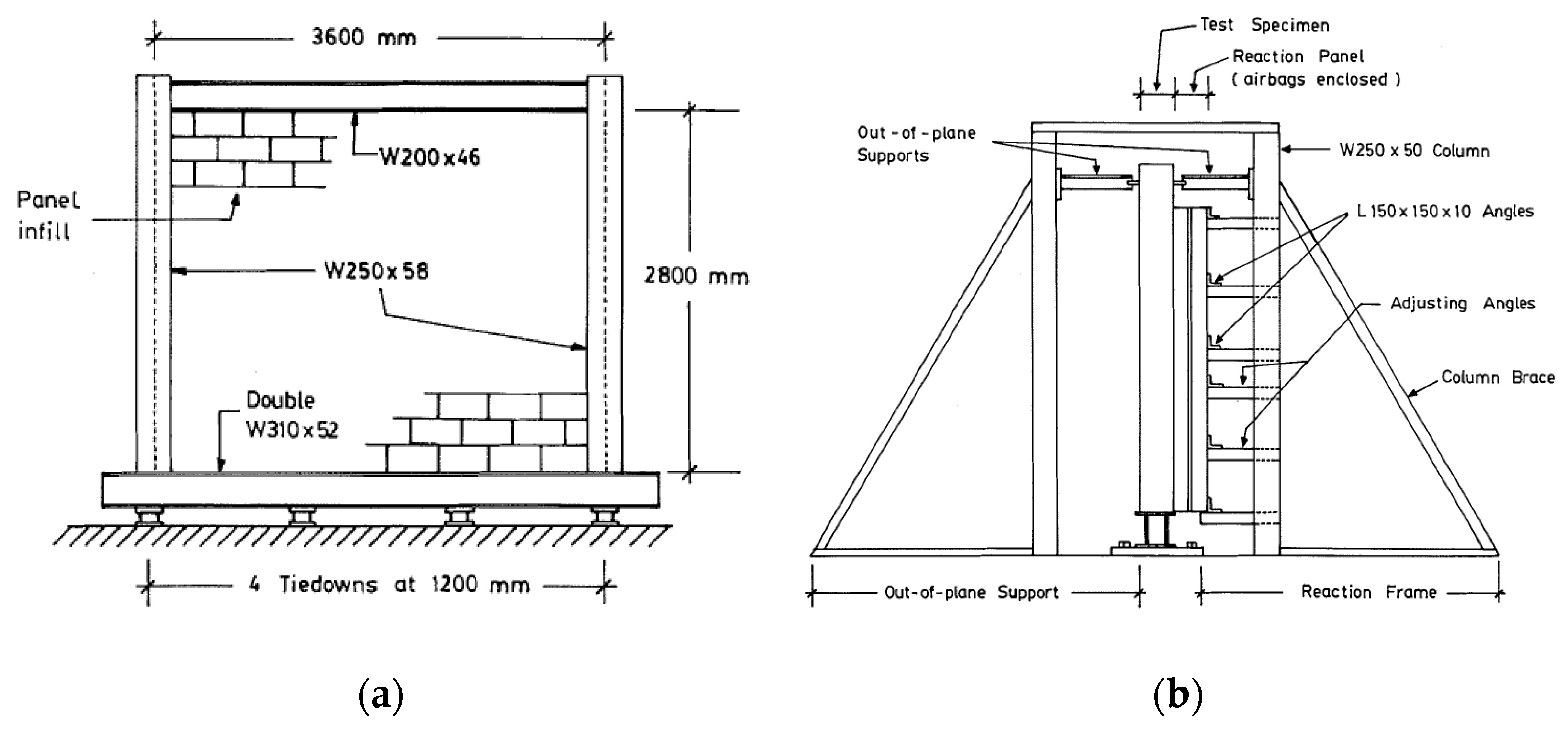


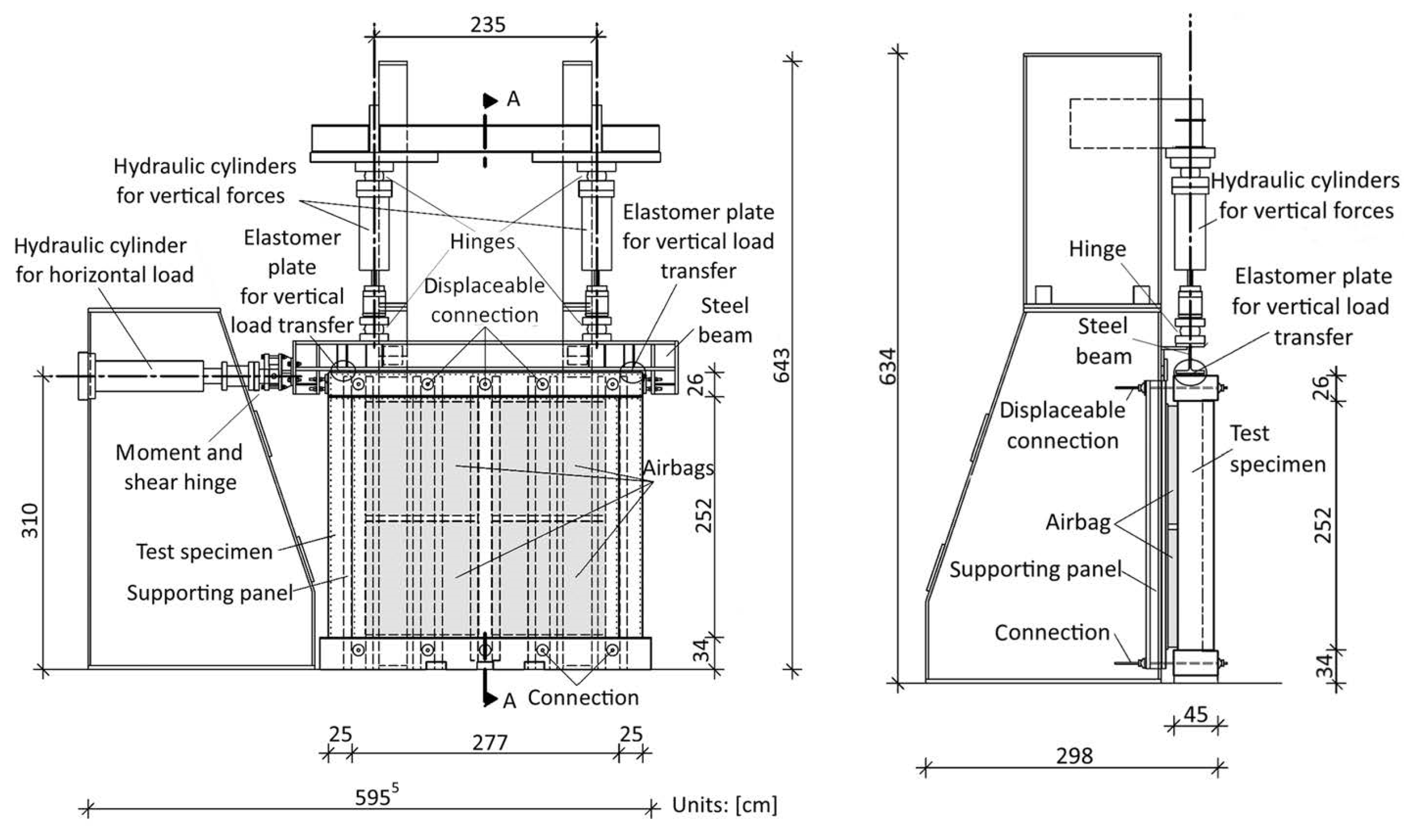








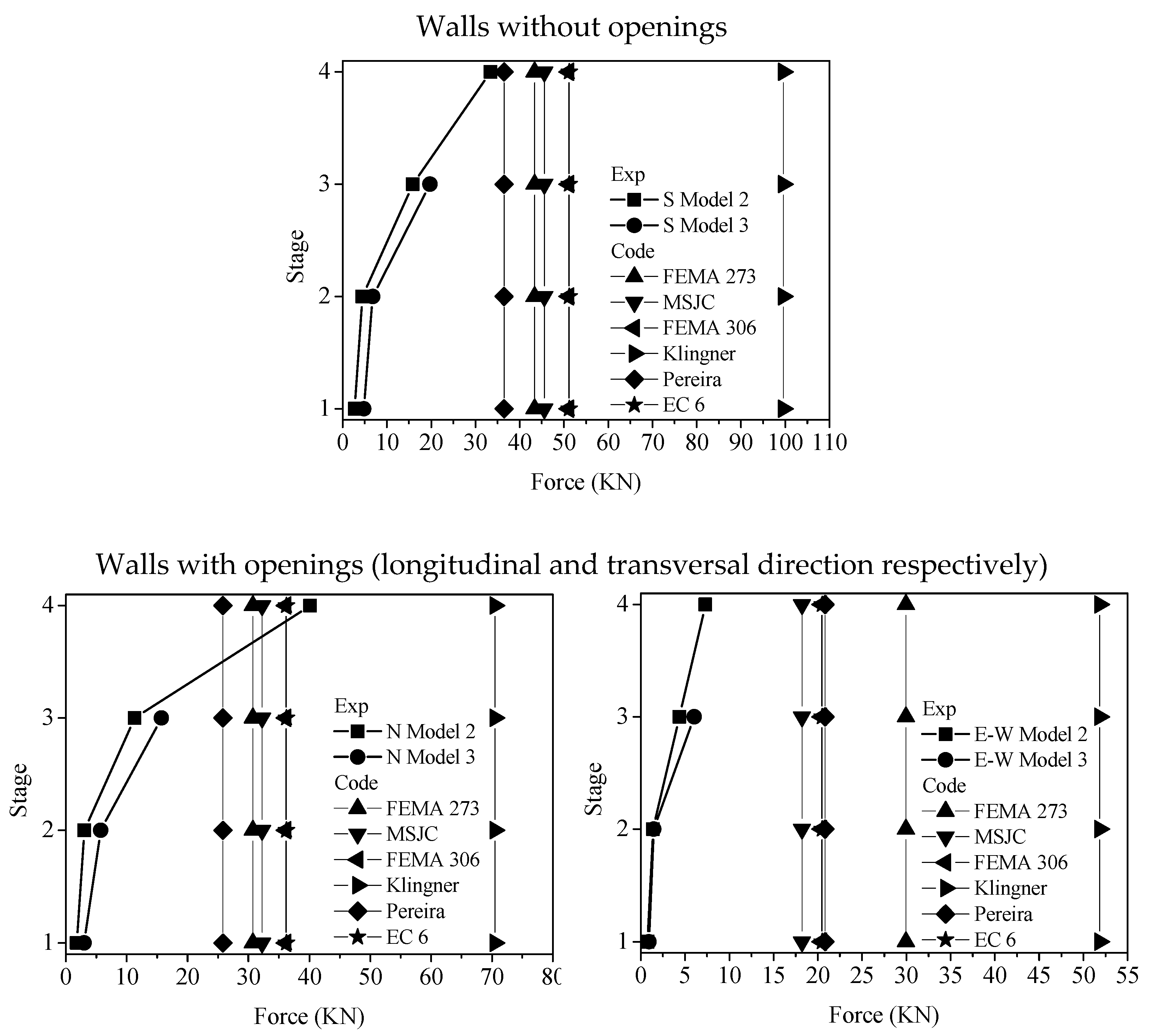


| Slenderness | |
|---|---|
| 5 | 0.129 |
| 10 | 0.030 |
| 15 | 0.034 |
| 35 | 0.013 |
| Structural Performance Level | Flexible Diaphragms | Other Diaphragms |
|---|---|---|
| Collapse prevention | 0.9 | 0.3 |
| Life safety | 1.2 | 0.4 |
| Immediate occupancy | 1.8 | 0.6 |
| Model Number | Design Standards | Concrete Class | Rebar Class | Infill Solution |
|---|---|---|---|---|
| 1 | RSA/REBAP | C20/25 | S400 | Double leaf clay brick unreinforced wall |
| 2 | EC2/EC8 | C30/37 | S500 | Single leaf clay brick wall with bed joint reinforcement every two joints |
| 3 | EC2/EC8 | C30/37 | S500 | Single leaf clay brick wall with reinforced plaster on both sides |
| Stage | Identification | Description |
|---|---|---|
| 1 | DI 0 | Initial dynamic identification test |
| DL | Seismic test based on Damage Limitation—225 YRP | |
| DI 1 | Dynamic identification test after the first stage | |
| 2 | SD | Seismic test based on Significant Damage—475 YRP |
| DI 2 | Dynamic identification test after the second stage | |
| 3 | NC | Seismic test based on Near Collapse—2475 YRP |
| DI 3 | Dynamic identification test after the third stage | |
| 4 | 1.5xNC | Seismic test with an amplitude of 1.5 times the previous stage—4574 YRP |
| DI 4 | Dynamic identification test after the fourth stage |
| Standard | Analytical Solution |
|---|---|
| FEMA 302 [24] and 306 [22] | |
| EC8 [27] | |
| FEMA 356 [25] | |
| NZS 1170.5 [26] |
| Standard | Analytical Solution |
|---|---|
| FEMA 273 [21] | |
| MSJC [20]/Seah and Dawe [7] | |
| FEMA 306 [22] and Angel [10] | |
| Klingner et al. [11] | |
| Pereira [15] | |
| EC6 [28] |
| Wall | Type | Experimental Frequency (Hz) | Analytical (Hz) | Error (%) | |
|---|---|---|---|---|---|
| Model 1 | P1 exterior leaf | With openings | 60.5 | 11.0 | −81.8 |
| P1 interior leaf | With openings | 57.5 | 16.1 | −72.1 | |
| P2 exterior leaf | With openings | 66.7 | 11.0 | −83.5 | |
| P2 interior leaf | With openings | 59.5 | 16.1 | −73.0 | |
| P1 exterior leaf | Solid | 69.4 | 11.0 | −84.1 | |
| P1 interior leaf | Solid | 62.8 | 16.1 | −74.4 | |
| P2 exterior leaf | Solid | 70.7 | 11.0 | −84.4 | |
| P2 interior leaf | Solid | 67.1 | 16.1 | −76.1 | |
| Model 2 | P1 North | With openings | 56.9 | 5.1 | −91.0 |
| P1 South | Solid | 67.0 | −92.4 | ||
| P2 South | Solid | 65.0 | −92.1 | ||
| Model 3 | P1 North | With openings | 56.3 | 5.1 | −90.9 |
| P1 South | Solid | 64.1 | −92.0 | ||
| P2 South | Solid | 66.7 | −92.3 |
| Fixed | Simply Supported | |
|---|---|---|
| Connected to the beams |  |  |
| Interior: 42.0 Hz Exterior: 51.4 Hz | Interior: 18.7 Hz Exterior: 23.0 Hz | |
| Connected to the columns |  |  |
| Interior: 10.0 Hz Exterior: 12.3 Hz | Interior: 4.4 Hz Exterior: 5.4 Hz | |
| Connected to the columns and lower beam |  |  |
| Interior: 14.7 Hz Exterior: 18.0 Hz | Interior: 7.7 Hz Exterior: 9.5 Hz | |
| Connected to the beams and columns |  |  |
| Interior: 45.7 Hz Exterior: 56.0 Hz | Interior: 22.8 Hz Exterior: 28.1 Hz |
| Fixed | Simply Supported | |
|---|---|---|
| Connected to the beams |  |  |
| 84.5 Hz | 39.6 Hz | |
| Connected to the columns | 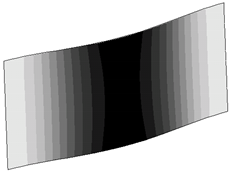 |  |
| 20.9 Hz | 9.3 Hz | |
| Connected to the columns and lower beam |  |  |
| 30.3 Hz | 15.8 Hz | |
| Connected to the beams and columns |  |  |
| 91.8 Hz | 47.0 Hz |
| New Proposal | |||||
|---|---|---|---|---|---|
| Wall | Type | Experimental Frequency (Hz) | Constrained on 4 Sides (Hz) | Error (%) | |
| Model 1 | P1 exterior leaf | With openings | 60.5 | 48.4 | −20.1 |
| P1 interior leaf | With openings | 57.5 | 37.6 | −36.4 | |
| P2 exterior leaf | With openings | 66.7 | 48.4 | −27.5 | |
| P2 interior leaf | With openings | 59.5 | 37.6 | −36.8 | |
| P1 exterior leaf | Solid | 69.4 | 48.4 | −30.3 | |
| P1 interior leaf | Solid | 62.8 | 37.6 | −40.1 | |
| P2 exterior leaf | Solid | 70.7 | 48.4 | −31.6 | |
| P2 interior leaf | Solid | 67.1 | 37.6 | −43.9 | |
| Model 2 | P1 North | With openings | 56.9 | 80.6 | 41.7 |
| P1 South | Solid | 67.0 | 20.3 | ||
| P2 South | Solid | 65.0 | 24.0 | ||
| Model 3 | P1 North | With openings | 56.3 | 80.6 | 43.2 |
| P1 South | Solid | 64.1 | 25.8 | ||
| P2 South | Solid | 66.7 | 20.9 | ||
| Analytical Value (KN) | Experimental Value (KN) | Reduced Analytical Value (KN) | Error (%) | |
|---|---|---|---|---|
| FEMA 273 [21] | 30.0 | 7.3 | 9 | 23.3 |
| MSJC [20] | 18.2 | 5.5 | −38.9 | |
| FEMA 306 [22] | 20.4 | 6.1 | −16.2 | |
| Klingner et al. [11] | 51.8 | 15.4 | 114.2 | |
| Pereira [15] | 20.8 | 6.2 | −14.5 | |
| EC6 [28] | 20.5 | 6.2 | −15.8 |
Publisher’s Note: MDPI stays neutral with regard to jurisdictional claims in published maps and institutional affiliations. |
© 2022 by the authors. Licensee MDPI, Basel, Switzerland. This article is an open access article distributed under the terms and conditions of the Creative Commons Attribution (CC BY) license (https://creativecommons.org/licenses/by/4.0/).
Share and Cite
Leite, J.; Lourenço, P.B.; Mendes, N. Design Proposal for Masonry Infill Walls Subject to Seismic Actions. Appl. Sci. 2022, 12, 503. https://doi.org/10.3390/app12010503
Leite J, Lourenço PB, Mendes N. Design Proposal for Masonry Infill Walls Subject to Seismic Actions. Applied Sciences. 2022; 12(1):503. https://doi.org/10.3390/app12010503
Chicago/Turabian StyleLeite, João, Paulo B. Lourenço, and Nuno Mendes. 2022. "Design Proposal for Masonry Infill Walls Subject to Seismic Actions" Applied Sciences 12, no. 1: 503. https://doi.org/10.3390/app12010503
APA StyleLeite, J., Lourenço, P. B., & Mendes, N. (2022). Design Proposal for Masonry Infill Walls Subject to Seismic Actions. Applied Sciences, 12(1), 503. https://doi.org/10.3390/app12010503






